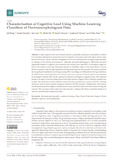JavaScript is disabled for your browser. Some features of this site may not work without it.
| dc.contributor.author | Wang, Qi | |
| dc.contributor.author | Smythe, Daniel | |
| dc.contributor.author | Cao, Jun | |
| dc.contributor.author | Hu, Zhilin | |
| dc.contributor.author | Proctor, Karl J. | |
| dc.contributor.author | Owens, Andrew P. | |
| dc.contributor.author | Zhao, Yifan | |
| dc.date.accessioned | 2023-10-20T14:22:49Z | |
| dc.date.available | 2023-10-20T14:22:49Z | |
| dc.date.issued | 2023-10-17 | |
| dc.identifier.citation | Wang Q, Smythe D, Cao J, et al., (2023) Characterisation of cognitive load using machine learning classifiers of electroencephalogram data. Sensors, Volume 23, Issue 20, Article number 8528 | en_UK |
| dc.identifier.issn | 1424-8220 | |
| dc.identifier.uri | https://doi.org/10.3390/s23208528 | |
| dc.identifier.uri | https://dspace.lib.cranfield.ac.uk/handle/1826/20423 | |
| dc.description.abstract | A high cognitive load can overload a person, potentially resulting in catastrophic accidents. It is therefore important to ensure the level of cognitive load associated with safety-critical tasks (such as driving a vehicle) remains manageable for drivers, enabling them to respond appropriately to changes in the driving environment. Although electroencephalography (EEG) has attracted significant interest in cognitive load research, few studies have used EEG to investigate cognitive load in the context of driving. This paper presents a feasibility study on the simulation of various levels of cognitive load through designing and implementing four driving tasks. We employ machine learning-based classification techniques using EEG recordings to differentiate driving conditions. An EEG dataset containing these four driving tasks from a group of 20 participants was collected to investigate whether EEG can be used as an indicator of changes in cognitive load. The collected dataset was used to train four Deep Neural Networks and four Support Vector Machine classification models. The results showed that the best model achieved a classification accuracy of 90.37%, utilising statistical features from multiple frequency bands in 24 EEG channels. Furthermore, the Gamma and Beta bands achieved higher classification accuracy than the Alpha and Theta bands during the analysis. The outcomes of this study have the potential to enhance the Human–Machine Interface of vehicles, contributing to improved safety. | en_UK |
| dc.language.iso | en | en_UK |
| dc.publisher | MDPI | en_UK |
| dc.rights | Attribution 4.0 International | * |
| dc.rights.uri | http://creativecommons.org/licenses/by/4.0/ | * |
| dc.subject | electroencephalography | en_UK |
| dc.subject | machine learning | en_UK |
| dc.subject | Deep Neural Network | en_UK |
| dc.subject | Support Vector Machine | en_UK |
| dc.subject | cognitive load classification | en_UK |
| dc.title | Characterisation of cognitive load using machine learning classifiers of electroencephalogram data | en_UK |
| dc.type | Article | en_UK |
Files in this item
The following license files are associated with this item:
This item appears in the following Collection(s)
-
Staff publications (SATM) [4411]

